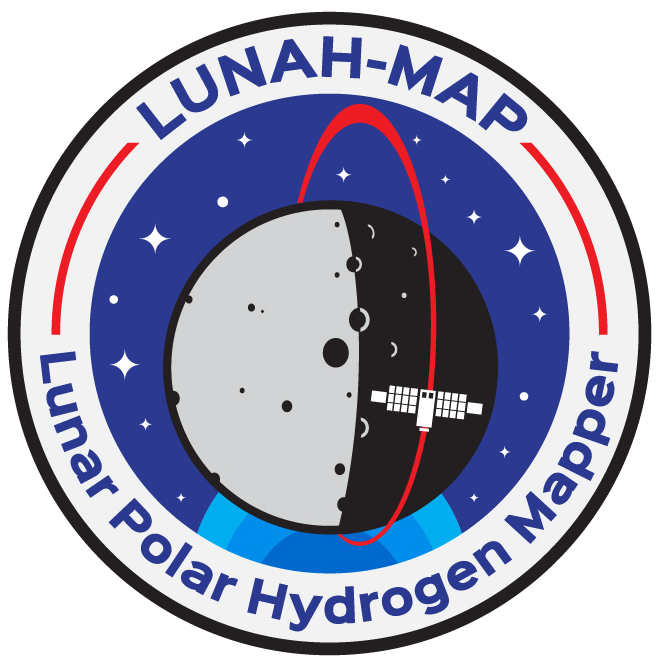The Lunar Polar Hydrogen Mapper (LunaH-Map) is a 6U CubeSat selected for flight under NASA’s Small, Innovative Missions for Planetary Exploration (SIMPLEx) program. LunaH-Map is manifested as a secondary payload on the Space Launch System (SLS) Exploration Mission 1 (EM-1).
The Lunar Polar Hydrogen Mapper (LunaH-Map) mission will map the distribution of hydrogen around the lunar South Pole using a miniature neutron spectrometer. The mission builds upon a decade of lunar science, which has revealed both regional and more localized enrichments of water ice near the lunar poles. Localized enrichments are primarily within permanently shadowed regions (PSRs) and craters throughout the South Pole. The spatial extent of these regions is often below the resolution of previous neutron instruments that have flown on lunar missions. The neutron leakage spectrum from planetary surfaces is primarily sensitive to hydrogen abundance in the top meter of regolith, however, for neutron spectrometers with omnidirectional sensitivity, the spatial resolution is limited by the spacecraft orbital altitude above the surface. A low altitude measurement from a distance on the same scale of the PSRs could spatially isolate and constrain the hydrogen enrichments both within and around within those regions. A small spacecraft mission is ideally suited to acquire the low-altitude measurements required to localize hydrogen enrichments using neutron spectroscopy at the lunar South Pole. LunaH-Map will use a solid iodine ion propulsion system, X-Band radio communications through the NASA Deep Space Network, star tracker, Command & Data Handling System, and EPS systems from Blue Canyon Technologies, solar arrays from MMA Designs, LLC, mission design and navigation by KinetX. Spacecraft systems design, integration, qualification, test, and mission operations are performed by Arizona State University, AZ Space Technologies and Qwaltec.
 My contribution to the LunaH-Map mission consisted of calibrating and characterizing the Mini-NS in collaboration with RMD Inc. and LANL at the Los Alamos National Labs Neutron Free-in-Air Facility. We successfully collected data in December 2018 and are in the process of analyzing the calibration data and writing the instrument paper. I also wrote a python code to convert the space-flight binary data packets (level-0 data) into organized ascii .txt files (level-1 data) that can be more easily analyzed.
My contribution to the LunaH-Map mission consisted of calibrating and characterizing the Mini-NS in collaboration with RMD Inc. and LANL at the Los Alamos National Labs Neutron Free-in-Air Facility. We successfully collected data in December 2018 and are in the process of analyzing the calibration data and writing the instrument paper. I also wrote a python code to convert the space-flight binary data packets (level-0 data) into organized ascii .txt files (level-1 data) that can be more easily analyzed.
Abstracts/Presentations:
Publications:

In Prep (as co-author):
- Calibration and Data Processing of the Miniature Neutron Spectrometer (Mini-NS) for the Lunar Polar Hydrogen Mapper Mission (LunaH-Map)
Abstract:
Nuclear techniques have been used successfully in many of the previous planetary missions as a remote sensing method from orbit to investigate the water (or hydrogen) content in the shallow subsurface and to determine the surface composition of planetary bodies. As the Moon is without an atmosphere, galactic cosmic rays can interact with the lunar surface, producing neutrons, and the epithermal neutron flux decreases as hydrogen content increases. To understand the presence of water within permanently shadowed regions, Lunar Polar Hydrogen Mapper (LunaH-Map) mission is designed to provide a high-resolution spatial distribution of the hydrogen content over the southern pole from a highly elliptical, low perilune orbit. The instrument on the LunaH-Map mission is the Miniature Neutron Spectrometer (Mini-NS), which consists of 8, 2-cm thick slabs of Cs2YLiCl6:Ce (CLYC), which provide a thermal neutron sensitivity similar to a 10-atm, 5.7-cm diameter He-3 tubes, as used in the Lunar Prospector Neutron Spectrometer (LPNS). The Mini-NS has a total active area of 200 cm^2 covered with a gadolinium sheet to discriminate thermal neutrons from epithermal. The Mini-NS uses pulse shape discrimination (PSD) techniques implemented in a field programmable gate array (FPGA), and it is integrated into a 6U cubesat to be launched on the Artemis-I vehicle via NASA’s new rocket, the Space Launch System (SLS). This paper describes the instrument hardware & software, ground & flight data processing, and neutron efficiency & thermal calibration of the Mini-NS instrument at Los Alamos National Labs (LANL) Neutron Free in Air (NFIA) Facility. We report on the total efficiency, angular efficiency, and angular response function of the instrument. Based on angular efficiency projections for an orbit of 10 – 15 km, Mini-NS is able to map thermal neutrons with a field of view (FOV) of less than 40 – 60 km, respectively.